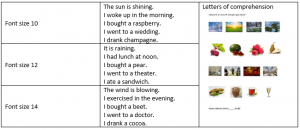The writer of the blog: Rita Farkasné Gönczi
The use of easy-to-understand communication dates back decades in Hungary, one of the foundations of which is to ensure equal access to information. The history of easy to understand communication was very diverse in Hungary. The first event is that the ÉFOÉSZ adapted the easy to understand communication to Hungary, which it continuously uses in its publications and holds trainings on the subject (Horváth, Ladányi, 2021). For the first time in Hungary, easy-to-understand communication appeared online in 2011. I launched a blog called Easy-to-understand kitchen, where recipes with easy-to-understand communication were available. From 2017, the blog moved to the website http://konnyenertheto.gonczirita.hu/english , where professional knowledge and publication collections related to easy-to-understand communication appeared.
In the meantime, I worked with experts by experience to develop the concept of easy-to-understand communication in Hungary. “Easy-to-understand communication is the display of content units of information appearing in the common language or at a more complex language level, or the development of independently created information content in a simple, clear form for understanding information” (http://konnyenertheto.gonczirita.hu/english/definition-easy-to-understand/, 2017, lc. 2018, modified 2021).” Easy-to-understand communication is communication that uses linguistic and non-linguistic signs in many cases along specific rules. Easy-to-understand communication uses each language’s own linguistic and non-linguistic cues to develop and convey the message. Individual application means that the level of comprehension of the people involved in the communication determines the level of communication that is easy to understand and according to which the range of grammatical and other rules can be adjusted. Participants in easy-to-understand communication consciously or spontaneously apply the rules of message formation that appear in the communication situation” (Rita Farkasné Gönczi, 2021).

1. figure: system for the use of linguistic and non-linguistic signs in easy-to-understand communication (Farkasné Gönczi Rita, 2021).
The use of language symbols (strings and their written image) refers to the rules for that language. The use of non-linguistic signs in speech clarifies or modifies comprehension, possibly as a message in itself.
The formal rules that appear in the method of easy-to-understand communication are actually the use of non-linguistic signs themselves.
Researching 2 formal rules of easy-to-understand communication
The real effectiveness of formal rules have not been studied much in Hungary. I first conducted an examination of 2 formal rules among experts by experience in Hungary in 2018, and then in 2019. The non-representative study included 44 individuals with intellectual disabilities. Among the formal rules, I reviewed the rules on font size and shape background in international and domestic regulators, and then adjusted the examination tool for this. The basis for examining the two rules is my hypothesis that font size and shape-background rules can be modified by the proliferation of digital platforms and their frequent use.
My questions for reading comprehension:
-
- Does the larger font size really support intelligent reading?
- In terms of font size, which font size do test subjects prefer?
- Does the shape-background rule in the light background, dark font version really support intelligent reading?
- Which shape-background form do test subjects consider supportive?
In both cases, we asked the person to read the text. We measured the reading speed. Then weasked him to select an image that matched the sentences from the images in the queue. The correct selections were scored. We asked people which text they considered easy to read and which they read faster.

Table 1: The font size rule for easy-to-understand communication research material, KÉK-BM (Farkasné Gönczi, Sugatagi & Szilágyi, 2019, 323).

Table 2: Research material on the shape-background rule of easy-to-understand communication, KÉK-BH (Farkasné Gönczi, Sugatagi & Szilágyi 2019, 323).
There is no significant difference between the font size and the background of the letters, neither in the reading speed (sign. 0.745) nor in the number of correctly understood texts (sign. 0,200) for each font size. In the reading speed it was found that at the letter-background (sign. 0.049), the comparison is just below the standard significance level of 5% in the statistical sense, so the unusual text with a dark background can be considered to be read significantly faster (Farkasné Gönczi, Sugatagi & Szilágyi 2019). Based on the results, the application of letter background rules is of little need among the subjects. This may be due to the intensifying digital look where we come across a wide variety of text and backgrounds. It would be worthwhile to resaurch the larger population.
Based on the results of the non-representative small-sample research presented above, it can be seen that the rules used in easy-to-understand communication derive from practice and little research has addressed their effectiveness. The present research examining the applicability of the two formal rules of easy-to-understand communication can only show a trend and serve as a basis for future interdisciplinary research.
The development of rules for easy-to-understand communication such as intralinguistic translation can be influenced by several disciplines. The rules for the use of linguistic signs refer, for example, to linguistics or translation science. The rules for the use of non-linguistic signs refer, for example, to the communication sciences. The effectiveness of the use of easy-to-understand communication among people with intellectual disabilities is the science of special education. This may be one way to make easy-to-understand communication an interdisciplinary science.
We were the first in Hungary to address these issues at an international conference on easy-to-understand communication organized by the community of my website and the ELTE Bárczi Gusztáv Faculty of Special Needs Education on 4 June 2021 (http://konnyenertheto.gonczirita.hu/konnyen-ertheto-konferencia/).
About the writer: Rita Farkasné dr. Gönczi is a PhD at the University of special education in Hungary, who was the first to describe the definition of easy-to-understand communication and conducted empirical research on the subject in Hungary. Edit her own professional website on the subject from 2011, where she works with Experts by experience: http://konnyenertheto.gonczirita.hu/english/
References:
Peter László Horvath, Lili Ladányi (2021). Easy Language in Hungary. In: Camilla Lindholm, Ulla Vanhatalo (eds.) Handbook of Easy Languages in Europe. Frank & Timme, Berlin.
Rita Farkasné Gönczi (2021). The concept of easy-to-understand communication, language levels, and applicability in the context of visual impairment. In Dimensional changes in the pedagogy and rehabilitation of the visually impaired. International conference organized by the Gusztáv Bárczi Faculty of Special Education at the Eötvös Loránd University on the occasion of the Hungarian Science Festival. (ed. Farkas Gönczi), ELTE BGGYK, Budapest.
Rita Farkasné Gönczi, Gábor Sugatagi, Lajosné Szilágyi (2019): A small sample test of the 2 formal rules of easy-to-understand communication. In: Farkasné Dr. Rita Gönczi, Dr. Ferencné Gereben, Dr. Zoltán Lénárt (ed.) Rehabilitation ages, institutions, needs and opportunities in the Hungarian system of services. Volume of a study on the 47th National Professional Conference. Association of Hungarian Special Education Teachers, Gárdony. URL: https://edit.elte.hu/xmlui/handle/10831/46035, download: 11/28/2021
Rita Farkasné Gönczi (2018). The concept and rules of easy-to-understand communication are based on international and domestic examples and the suggestions of Hungarian experts by experience. Special Educational Review, 46 (1), 64-76.
Rita Farkasné Gönczi, Éva Graf-Jaksa (2009). Easy to understand communication in Communication and Information Technology and Disability. Disability Science Knowledge Base, ELTEBGGYK.

Dear Rita,
according to some theories, we should not even talk about easy-to-understand communication, but about a distinct language. Based on your research so far, what do you think of this theory?
Dear Kriszta,
we could talk about one language, because we translate within one language, it means intralingual translation. Easy-to-understand communication is more than that, because in addition to language signs, we also use non-language signs in translation or text creation. This is already a matter of communication.
Dear Rita,
thank you for your reply!
Dear Rita,
my expereience is that for a long time we did not even think about the effectiveness of the rules in Hungary, we just adapted them from the international movement and used them. In the last couple of years more and more easy-to-read texts started to appear, with more and more people reading them and self-advocates starting to epmhasize more loudly the need for such information. The time has become to dig deeper, rethink the rules and provide a better quality in making information accessible. You work is a very good start for this! I am looking forward to a bigger study with bigger numbers of test subjects.